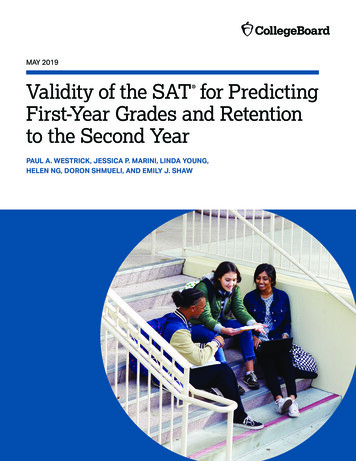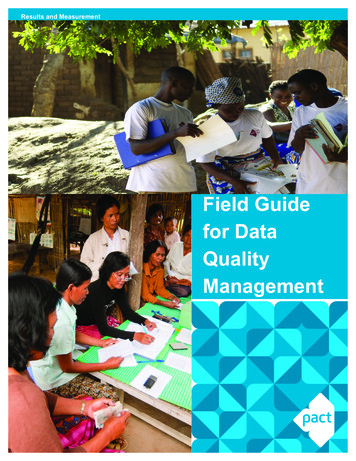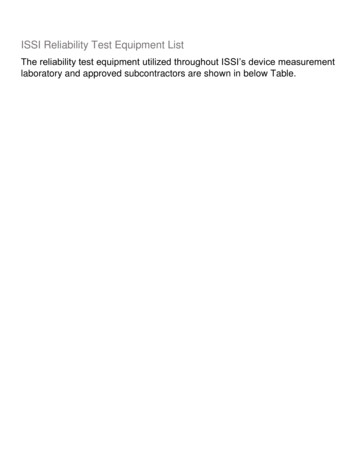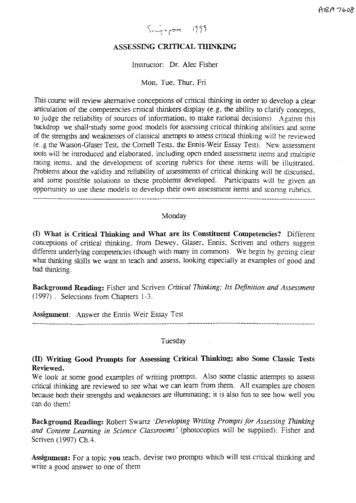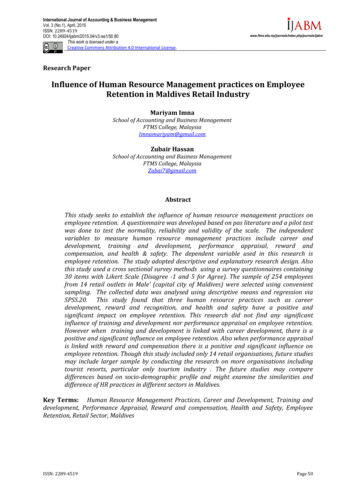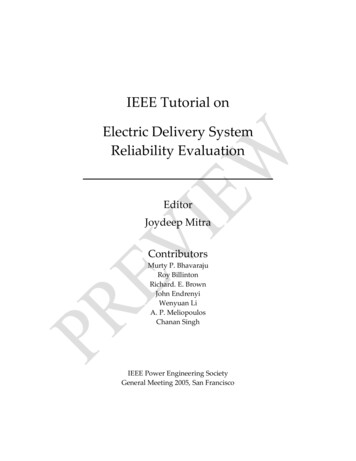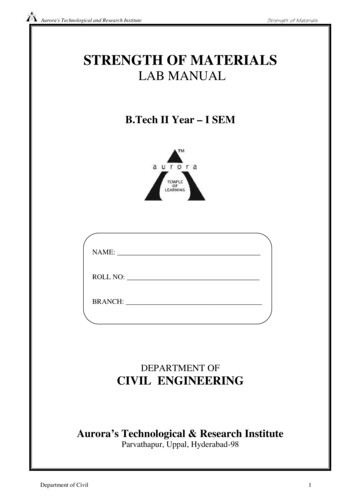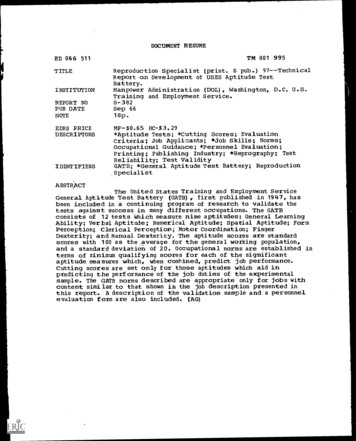
Transcription
DOCUMENT RESUMETM 001 995ED 066 511TITLEINSTITUTIONReproduction Specialist (print. & pub.) 97--TechnicalReport on Development of USES Aptitude TestBattery.Manpower Admi ni strati on (DOL), Washington, D.C. U.S.Training and Employment Service.REPORT NOPUB DATES-382Sep 66NOTE18p .EDRS PRICEMF- 0.65 BC- 3.29DESCRIPTORSIDENTIFIERS*Aptitude Tests; *Cutting Scores; EvaluationCriteria; Job Applk ants; *Job Skills; Norms;Occupational Guidance; *Personnel Evaluation;Printing; Publishing Industry; *Reprography; TestReliability; Test ValidityGATB; *General Aptitude Test Battery; ReproductionSpecialistABSTRIACTThe United States Training and Employment ServiceGeneral Aptitude Test Battery (GATB) , first published in 19147, hasbeen included in a continuing program of research to validate thetests against success in many different occupations. The GATBconsists of 12 tests Which measure nine aptitudes; General LearningAbility; Verbal Aptitude; Numerical Aptitude; Spatial Aptitude; FormPerception; Clerical Perceptior, Motor Coordination; FingerDexterity; and Manual Dexterity. The aptitude scores are standardscores with 100 as the .average for the general working population,and a standard deviation of 20. Occupational norms are established interms of rrininum qualifying scores for each of the significantaptitude measures which, when combined, predict job performance.Cutting scores are set only for those aptitudes which aid inpredicting the performance of the job duties of the experimentalsample. The GATB norms described are appropriate only for jobs withcontent similar to that shown in the job description presented inthis report. A description of the validation sample and a personnelevaluation form are also included. (AG)
5-382United States Employment Service Technical ReportSeptember 1966U.S. DEPARTMENT OF HEALTH,EDUCATION & WELFAREOFFICE OF EDUCATIONTHIS DOCUMENT HAS BEEN REPRO.OUCH) EXACTLY AS RECEIVED FROMTHE PERSON OR ORGANIZATION ORIGINATING IT POINTS OF VIEW OR OPINIONS STATED 00 NOT NECESSARILYREPRESENT OFFICIAL OFFICE OF EDUCATION POSITION OR POLICYit)o4-Development of USES Aptitude Test BatteryforReproduction Specialist(print. & pub.) 97(U.S. DEPARTMENT OF LABORW. Willard Wirtz, SecretaryAININISTRATIONIUREAU OF EMPLOYMENT SECURITYWu WINN, D.C. 102111
Technical Report on Development o r USES Aptitude Test BatteryFor .Reproduction Specialist 97XXS-382U. S. Employment Servicein Cooperation withPennsylvania State Ehployment ServiceSeptember 1966
FOREWORDThe United States Employment Service General Aptitude Test BatterySince that time the GATB has(GATB) was first published in 1947.been included in a continuing program of research to validate thetests against success in many different occupations. Because of itsextensive research base the GATB has come to be recognized as thebest validated multiple aptitude test battery in existence for use invocational guidance.GeneralThe GATB consists of 12 tests which measure 9 aptitudes:Learning Ability, Verbal Aptitude, Numerical Aptitude, SpatialAptitude, Form Perception, Clerical Perception, Motor CoordinationFinger Dexterity, and Manual Dexterity. The aptitude scores arestandard scores with 100 as the average for the general workingpopulation, with a standard deviation of 20.Occupational norms are established in terms of minimum qualifyingscores for each of the significant aptitude measures which, incombination, predict job performance. For any given occupation,cutting scores are set only for those aptitudes which contributeto the prediction of performance of the job duties of the experiIt is important to recognize that another job mightmental sample.have the same job title but the job content might not be similar.The GATB norms described in this report are appropriate for usehat shown in the job descriponly for jobs with content similar ttion included in this report.Frank H. Cassell, DirectorU. S. Employment Service
GATB Study #2626DDIELOPMENT OF USES APTITUDE Tf HANERYForReproduction Specialist 97 XXThis report describes research undertaken for the purpose of developing GeneralAptitude Test Battery (GATB) norms for the occupation of Reproduction Specialist97XX. The following norms were established:Minimum AcceptableGATB, B-1002 ScoresGATB AptitudesG - General Learning AbilityN - Numerical AptitudeS - Spatial Aptitude9090RESEARCH SUNLMARYSample:79 trainees (62 male and 17 female) in Manpower and Development Training(MDfA) courses at Erie, Harrisburg and Monroeville (Pittsburgh)/Pennsylvania.Criterion:Supervisory ratingsDesign:Longitudinal (tests were administered at the beginning of training andcriterion data were collected at the end of training).Minimum aptitude requirements were determined on the basis of a jobanalysis and statistical analyses of aptitude mean scores, standarddeviations, aptitude-criterion correlations and selective efficiences.Predictive Validitz:Phi Coefficient .50 (P/2 .0005)Effectiveness of Norms:Only 65% of the non-test-selected trainees used for this study weregood trainees; if the trainees had been test-selected with the abovenorms, 85% would have been good trainees.35% of the non-test-selectedtrainees used for this study were poor trainees; if the trainees hadbeen test-selected with the above norms, only 15% would have been poortrainees. The effectiveness of the norms is shown graphically in Table 1:
2TABLE 1Effectiveness of NormsWithout TestsGood TraineesPoor Trainees65%35%With Tests85%15%SAMPLE DESCRIPTIONSize:N . 79Occupational Status:TraineesTraining Setting:Trainees were enrolled at three schools:Technical Memorial High SchoolErie, PennsylvaniaWilliam Penn High SchoolHarrisburg, PennsylvaniaForbes Trail Area Technical SchoolMonr oeville, PennsylvaniaSchool Selection Requirements:Education: High school graduates are preferred, but individuals who have completed the tenth grade are considered.Previous Experience:Tests:NoneNonePrincipal Activities:This training course covers several different jobs in order to assist employerswith small duplicating departments who require workers to do all of the taskscontained in the job description. The job duties and the course outline areshown in the Appendix.Minimum Experience:All individualsin the sample were trainees.
- 3 -TABLE 2Means, Standard Deviations (SD), Ranges, and Pearson Product-Moment Correlationswith the Criterion (r) for Age and EducationAge (years)Education EXPERIMENTAL TEsr BATTEHYAll 12 tests of the GATF3, B-1002, Form A, were administered prior to the startof training.CRITERIONMe criterion data consisted of instructors' ratings on each individual at thecompletion of training.Rating Scale:A descriptive rating scale for trainees was used.(See Appendix.) The scaleconsists of eight items covering different aspects of job performance. Eachitem has five alternatives corresponding to different degrees of jobproficiency.Reliability:Only one rating was obtained; no measure of criterion reliability wascomputed.Criterion Score Distribution:Possible Range:8-40Ac tual Range:8-40Mean:Standard Deviation:24.59.0Criterion Dichotomy:The criterion distribution was dichotomized into low and high groups byplacing 35% of the sample in the low group to correspond with the percentage of trainees considered unsatisfactory or marginal.Traineesin the high criterion group were designated as "good trainees" and thosein the low group as "poor trainees."
APTITUDES CONSIDERED FOR INCLUSION IN THE NORMSAptitudes were selected for tryout in the norms on the basis of a qualitativeanalysis of job duties involved and a statistical analysis of test and criteriondata. Aptitudes P and Q which do not have a high correlation with the criterionwere considered for inclusion in the norms because the qualitative analysis indicated that these aptitudes were important for the job duties and the sample hadhad a relatively high mean score on both aptitudes and a restricted range ofTables 3, 4 and 5 show thescores (low standard deviation) on apt,itude Q.results of the qualitative and statistical analyses.fABLE 3Qualitative Analysis(Based on the job analysis, the aptitudes indicated appear)to be important to the work performed)RationaleAptitude- General Learning AbilityMust use judgment in planning and performingoperations involved in printing a variety ofgraphic arts products.S - Spatial AptitudeNecessary to ascertain that materials to oereproduced are in proper alignment withNecessary in posiequipment being used.tioning negatives, plates, cony and othermaterials.P - Form PerceptionMust be able to perceive detail in reproduced black and uhite and colored printedmaterial, distinguisning shapes, colors,shadings and layout.Q - Clerical PerceptionMust possess the ability to proofreadnumerical and narrative data.M - Manual DexterityNecessary in operation of printingreproduction equipment.C.
-5TABLE 4Means, Standard Deviations (SD), Ranges and Pearson Product-Moment Correlationswith the Criterion (r) for the Aptitudes of the GA rB-VSP -12. 8105.712.618.016.113.2103.116.693. 1421.421.198.699.8Spatial Aptiturie101.5Form PerceptionClerical Percepti onK - Motor CoordinationFFinger Dexterity- Manual .8General Learning AbilityVerbal AptitudeN - Numerical AptitudeGRangeSDMeanAptitude99.3.242*.234*.328**. 21680-1378-13548-155-.004-.058.043.157*Significant at the .05 level**Significant at the .01 levelTABLE 5Summary of Qualitative and Quantitative DataApt itudesType of EvidenceG-VNSPQXXXXXKFMJob Analysis DataXImportantXIrrelevantRelatively High MeanRelatively Low Standard Dev.Significant Correlationwith CriterionAptitudes to be Consideredfor Trial NormsXXXXXXXGV NS POXXDERIVATION AND VALIDITY OF NORMSFinal norms were derived on the basis of a comparison of the degree to whichtrial norms consisting of various combinations of aptitudes G, kr, N, S. P andQ at trial cutting scores were able to differentiate between the 65% of thesample considered good workers and 35% of the sample considered poor workers.Trial cutting scores at five-point intervals approximately one stanoarddeviation below the mean are tried because this will eliminate about onethird of the sample with three-aptitude norms. For four-aptitude norms,
- 6 -cutting scores slightly lower than one standard deviation below the mean willeliminate about 1/3 of the sample; for two-aptitude norms, cutt,ing scores slightly higher than one standard deviation below the mean will eliminate about 1/3 ofthe sample.The Phi Coefficient was used as a basis for comparing trial norms.Norms of G-90, N-80 and S-90 provided the highest degree of differentiation forthe occupation of Reproduction Specialist 97XX. The validity of these normsis shown in Table 6 and is indicated by a Phi Coefficient of .50 (statisticallysignificant at the .0005 level).TABLE 6Predictive Validity of Test NormsG-90, N-80, and S-90NonqualifyingTest Scores122133Good TraineesPoor TraineesTotalPhi Coefficient(0) 50QualifyingTest ScoresTotal751281467939Chi Square (X2) 19.67Significance Level P12 0005DETERMINATION OF OCCUPATIONAL APTITUDE PATTERNThe data for this study did not meet the requirements for incorporating theoccupation studied into any of the 36 OAP's included in section II of theManual for the General Aptitude Test Battery.The data for this sample willbe considered for future groupings of occupations in the development of newoccupational aptitude patterns.
-7A-P-P-E-N-D-I-XRATING TRATNEESDESCRIPTIVE RATING SCALE(For Aptitude i'est Development Studies)ScoreRATING SCALE FORDirections:(DOT Title and Code for Training Course)Please read "RAIIING TRAINEES - SUGGESTIONS TO RATERS" andthen complete this rating scale. In making your ratings,only one box should be checked for each question.Name of trainee (print)Sex:MaleFemale(Last)(First )
8A.How much aptitude or facility does he have for the vocational training?(Trainee's adeptness or knack for performing the work easily and well.)1.Has great difficulty doing the Work.Not at all suited for thetraining.pi2.n 3.4.Usually has some difficulty doing the work. Not too well suitedfor the training.Does the work without tocr much difficulty.for the training.Usually does the work without difficulty.Fairly well suitedWell suited for thetraining.5.13.Exceptionally well suited forHow much ability does he have for maintaining adequate production in thevocational activity for which he was trained?ri1.riC.Does the work with great ease.the training.Capable of very low work output.unsatisfactory pace.Can perfom only at anCan perform at a slow pace.2.Capable of low work output.3.Capable of fair work output.not a fast pace.Can perform at an acceptable butri4.Capable of high work output.Can perform at a fast pace.5.Capable of very high work output.Can perform at an unusuallyfast pace.How good was the quality of his work during the vocational training?rin1.Performance was inferior and almost never met minimum qualitystandards.2.Performance was usually acceptable but somewhat inferior inquality. The grade of his work could stand improvement.Fl3.Performance was ac ceptable but usually not superior in quality.ri4.Performance was usually superior in quality.nS.Performance was almost always of the highest quality.
9D.How quickly did he learn the instructional units of the vocational training?flE.Learned the work very slowly.instructions.2.Learned the work somewhat slower than most.3.Learned most of the work in the usual amount of time.[14.Learned most of the work quickly.r--15.Learned all of the work very rapidly. Needed only the mdrdmumamount of training or instructions for even the difficUltaspects.How much ability does he have for mang the equipment of the vocationaltraining?ri1.F-1nF.Needed careful and repeated1.Has very limited ability.Cannot use the equipment adequately.Can use the equipment to "get by."2.Has little ability.3Has a moderate amount of ability.do fair work.Has high ability.5.Can use the equipment toCan use the equipment to do.good work.Has very high ability.work.Can use the equipment to do excellentHow large a variety of job duties can he perform efficiently?1.Cannot perform different operations adequately.2.Can perform a limited nudber of different operations efficiently.3.Can perform several different operations with reasonableefficiency.4.Can perforn many different operations efficiently.5 .ES-764 (1-65)Can perforn an unusually large variety of different operationsefficiently.12
- 10 -G.How resourceful is he in coping with work situations that are differentor out of the ordinary?/-7 1.L7.27H.2.Almost never is able to figure out what to do.on even minor problems.Often has difficult handling new situations.on all but simple problems.Needs helpNeeds helpaleL2:73.Sometimes knows what to do, sometimes doesn't.with problems that are not too complex.L.:74.Usually able to handle new situations.complex problems.L".:75.Practically always figures out what to do himself.needs help, even on complex problems.Can dealNeeds help on onlyRarelyConsidering all the factors alreacly rated, and ork these factors,how acceptable was his performance during vocational training?1.Performance was unsatisfactory.f:7 2.Performance was not completely satisfactory.f:7 3.Performance was satisfactory.E7L.Performance was good.f:75.Performance was outstanding.
S-382September 1966FACT SHEETJob Title:Reproduction Specialist 97ZXJob Summary:Plans and performs operations involved in printing a variety of graphicarts products by the cold type method on office-type lithographic presses.Work Performed:Vari -TypistVari -types price lists, circular letters, memos, manuals, tables, graphs,charts, reports and booklets. Selects suitable size and style of type.Recommends to originator the layout and format to be used. Uses draftingtable, T-square, ruling pen and other drafting tools to obtain desiredresults. Vari -types copy according to specifications. Makes finishedformat on vari -type master from copy. Rules, cuts and strips majorheadings and photographs in copy. Operates Headliner Machine to setbold headings. Finishes rough copy and makes ready for photographicmaster. Keeps lcg on jobs and hourly distribution.Opaquer/StripperPrepares combination negative masking jobs including basic colorseparation, Ben Day screens and set-up job for hairline separatiaa.Strips negatives and posities. Outlines, spots and opaques negatives.Assembles and performs paste-up of type proofs and illustrations.CameramanFastens the work to a large copyboard and photographs or copies it witha camera. Develops film; examines film and corrects or retouches ifnecessary. Maintains camera equipment in efficient working order.Maintains production schedule and customer negative files. MixesFolutions for developing negatives; maintains stock of negatives,photographic paper and solutions.PlatemakerStrips or tapes together several negatives in their proper positions on asheet of orange paper. Cuts windows in paper to expose printing areas(transparent) of the negatives. Takes thin aluminum or paper platecoated with a light sensitive emulsion and places in yam printing frame.Positions negative assembly over it and exposes it to a bright light.Removes plate from printing frame after exposure, covers it with a thincoating of ink and flushes it in plain water. CheAs negatives forexposure according to humidity and light strength. Makes solutions perstandard formulas, cleans and maintains equipment and work area in aneat and orderly condition. Maintains stock of essential solutions,masters and supplies.Assists in maintenance of production scheduleplate files.14
- 12 -Offset Duplicator OperatorOperates offset duplicating machine to reproduce multiple copies fromtyped, photographic or pre-sensitized masters. Makes necessaryadjustments on machine involving ink, water and pressure to insureoptimum results. Adjusts copy according to specifications. Followsinstructions from job ticket concerning color, position, bindingmargin, registration, quantity and quality. Keeps production log andsaves representative samples.BindingOperates binding equipment including cutter, drill, plastic binderycollator and electric stapler according to instructions.Cuts stockto required size before running on duplicator. Minimizes spoilage,overage and waste. Keeps record of various paper stocks.Performance RequirementsMust have thorough knowledge of all operations. Must have demonstratedfinger and manual dexterity. Must be neat and order4 in work. Mustconsistently contact public in a tactful and courteous manner.Physical RequirementsGood physical and mental health.Good eyesight and color discrimination.Course'OutlineOrientationVarityper and HeadlinerBasic Camera InstructionLithographyBindingClass ProblemsTotal hoursThere were slight variations in the number of hours for the Erie course.One copy should remain as part of the(This sheet is printed in duplicate.Appendix in order to complete the technical report. The other copy can beremoved by employment service personnel who wish to set up separate factsheet files.)GPO 91634315
S-382September 1966FACT SREETJob Title :Reproduction Specialist 97XXJob Summary :Plans and performs operations involved in printing a variety of graphicarts products by the cold type method on office-type lithographic presses.Work Performed:Vari rypistVari-types price lists, circular letters, memos, mmauals, tables, graphs,charts, reports and booklets. Selects suitable size and style of type.Recannends to originator the layout and format to be used. Uses draftingtable, T-square, ruling pen and other drafting tools to obtain desiredresults. Vari -types copy according to specifications. Makes finishedformat on vari -type master from copy. Rules, cuts and strips majorheadings and photographs in copy. Operates Headliner Machine to setbold headings. Finishes rough copy and makes ready for photogTaphicmaster.Keeps log on jobs and hourly distribution.Claquer/StrinnerPrepares combination negative masking jobs including basic colorseparation, Ben Day screens and 3etup job for hairline separation.Strips negatives and positives. Outlines, spots and opaques negatives.Assembles and performs paste-up of type proofs and illustrations.CameramanFastens the work to a large copyboard and photographs or copies it witha camera. Develops film; examines film and corrects or retoucheth ifnecessary. Maintains camera equipment in efficient working order.Maintains production schedule and customer negative files. Mixassolutions for developing negatives; maintains stock of negatives,photographic paper and solutions.PlatemakerStrips or tapes together several negatives in their proper positions on aCuts windows in paper to expose printing areassheet of orange pnper.(transparent) of the negatives. Takes thin aluminum or paper platecoated with a light sensitive emulsion and places in vacuum printing frame.Positions negative assembly over it and exposes it to a bright light.Removes plate from printing frana after exposure, cavers it with a thincoating of ink and flushes it in plain water. Checks negatives forexposure according to humidity and light strength. Mslas solutions perstandard formulas, cleans and maintains equipment and work area in aneat and orderly condition. Maintains stock of essential solutions,masters and supplies. Assists in maintenance of production scheduleplate files.
-12 -Offset Duplicator OperatorOperates offset duplicating machine to reproduce multiple copies fromtyped, photographic or pre-sensitized masters. Makes necessaryaajustments on machine involving ink, water and pressure to insureoptimum results. Adjusts copy according to specifications. Followsinstructions from job ticket concerning color, position, bindingmargin, regintration, quantity and quality.Keeps production log andsaves representative samples.BindingOperates binding equipment including cutter, drill, plastic binderycollator and electric stapler according to instructions. Cuts stockto required size before running on duplicator. Minimizes spoilage,overage and waste. Keeps record of various paper stocks.Performance RequirementsMust have thorough knowledge of all operations. Must have demonstratedfinger and manual dexterity. Must be neat and orderly in work. Mustconsistently contact public in a tactful and courteous manner.Physical RequirementsGood physical and mental health.Good eyesight and color discrimination.Course OutlineOrientationVarityper and HeadlinerBasic Camera InstructionLithographyBindingClass ProblemsTotal hoursThere were slight variations in the number of hours for the Erie course.(This sheet is printed in duplicate. One copy should remain as part of theAppendix in order to complete the technical report. The other copy can beremoved by employment service personnel who wish to set up separate factsheet files.)GPO 9 16 *34317
18
Longitudinal (tests were administered at the beginning of training and criterion data were collected at the end of training). Minimum aptitude requirements were determined on the basis of a job analysis and statistical analyses of aptitude mean scores, standard deviations, aptitude-criteri
